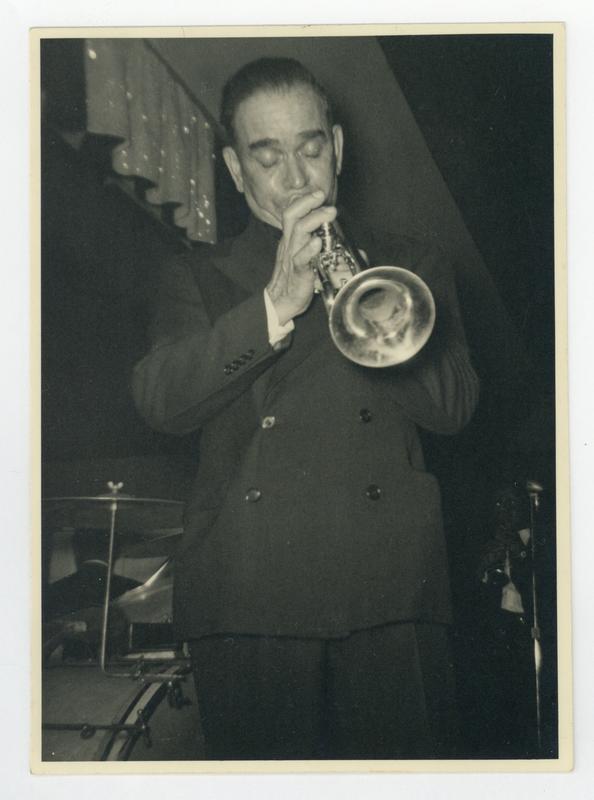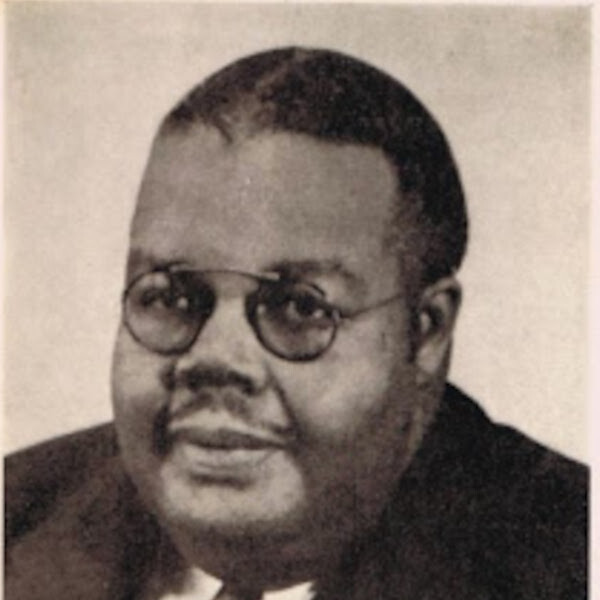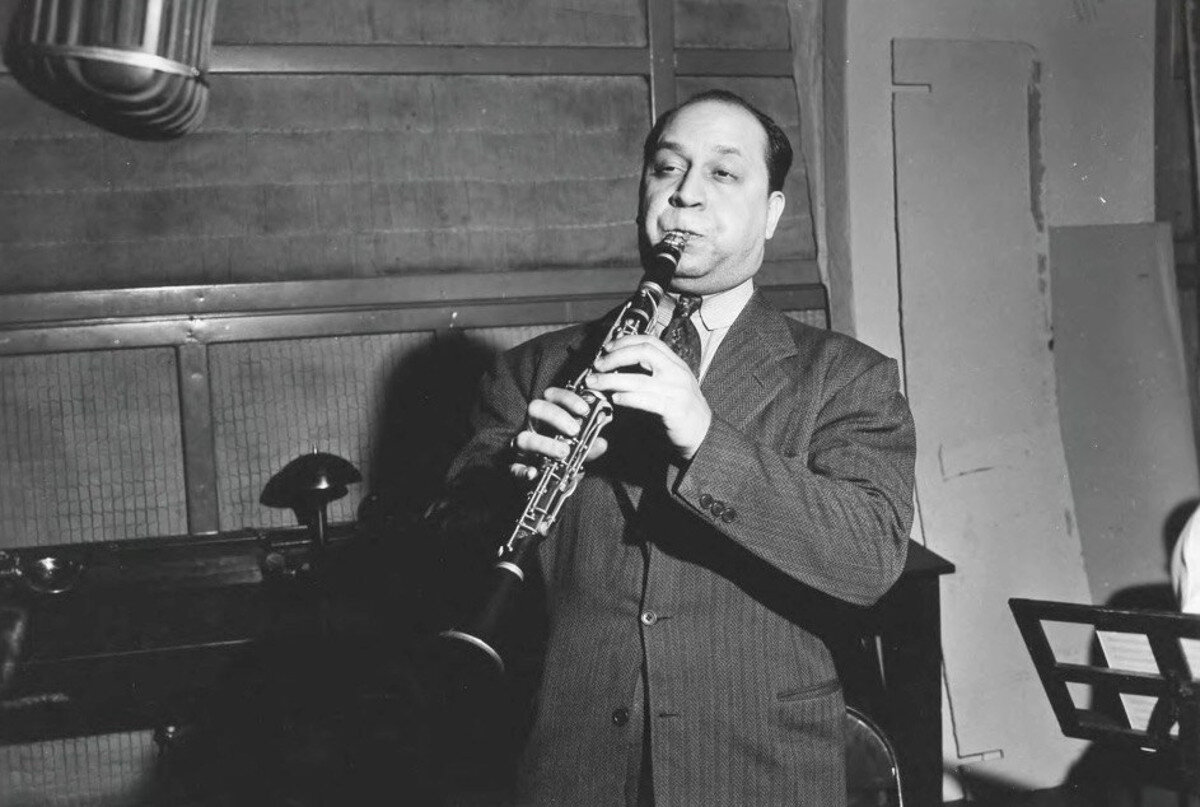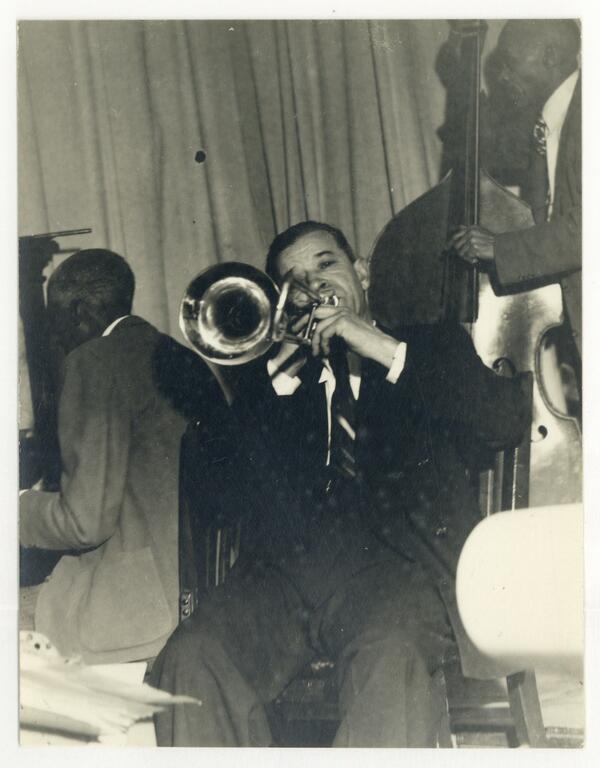Jeff Barnhart: Welcome back, hot music enthusiasts! This month, we offer the sequel to our exploration of trombonist Edward “Kid” Ory. On July 14th, 1926, the same musicians who had called themselves the New Orleans Wanderers in the studio the day prior returned to record four more immortal sides, this time as the New Orleans Bootblacks. Hal, take it away!
Hal Smith: The first song recorded on July 14, 1926 was “Mixed Salad.” There are some significant clams among the front-line instruments, but there is a nice ensemble spirit. Joe Clark takes a full chorus on alto sax and there are some wonderful breaks by banjoist St. Cyr and clarinetist Dodds. Ory doesn’t have much to do beyond playing ensemble parts, but you can definitely hear him playing his usual style.
The first four bars of the verse on “I Can’t Say” are reminiscent of the chorus of “Papa Dip.” And the chorus of “I Can’t Say” bears a close resemblance to Turk Murphy’s composition “Something For Annie.” But, as they say in 2022: “It’s all good!” Johnny Dodds plays a lovely solo, followed by a lyrical muted cornet solo by George Mitchell. Again, Kid Ory is confined to ensemble playing and again, he plays the parts to perfection. Jeff, what details would you add to my descriptions above?
JB: “Mixed Salad” lives up to its title! Clark rushes the bridge of the first chorus while Mitchell cracks a bit on the verse. I know you’ll be gnashing your teeth, Hal, but I really like Clark’s solo chorus; it’s hot with a nice ’20s tone. The concluding two ensembles have everyone hitting on all cylinders. Odd to have such a rough start to this session as they’d recorded four tunes as the N.O. Wanderers just the day before. Perhaps it’s because this was the first 32-bar tune they recorded? At any rate, the session just gets better and better.
I love the groove of “I Can’t Say!” Beautiful, bluesy playing by everyone in the front line. The melodies of both the chorus and verse are sobbingly soulful. The slowest tempo from this outfit gives everyone a chance to breathe and offer their best. Perhaps Ory simply opted to remain in the ensemble for this one. What’s next. Hal?
HS: Next up is one of my favorite classic jazz songs AND one of my favorite recordings from the 1920s: “Flat Foot.” This one just rocks, from the first note of the verse! Johnny St. Cyr’s banjo solo spotlights his bright tone and unshakeable beat. Lil’s syncopated piano break is just the right touch. George Mitchell picks up the last couple bars of the banjo solo and leads the ensemble into two more hot choruses. The penultimate chorus features a thrilling break by Johnny Dodds and the outchorus has my all-time favorite trombone break by Ory! Man, I remember the first time I ever heard this song: in 1967, played by the South Frisco Jazz Band with Papa Ray Ronnei on cornet. I have loved “Flat Foot” ever since then and this record is one I would grab in a fire.
The final song recorded by the Wanderers kept the energy level high: “Mad Dog.” The breaks on the intro are reminiscent of the Hot Five’s “Sweet Little Papa” and “Jazz Lips.” The minor verse sounds like “Palmer’s Georgia Grind” and the melody on the chorus is a forerunner of “The Last Time” (recorded by Louis Armstrong’s Hot Five in 1927). Ory is very active in the ensembles and Johnny Dodds plays two terrific choruses. Again, there are two hot outchoruses with the horns playing the intro as an outro. Listening to “Mad Dog” makes you wish that this band could have returned to the studio a day later and recorded four more sides!
JB: Oh, let’s be greedy: I wish they’d recorded four tunes a day throughout the rest of July!! Regarding “Flat Foot,” I admire the hot-yet-relaxed interplay between the four horns on the opening chorus. SO much is going on, but it’s never busy and they never get in each other’s way! And Lil, WOW!! Hearing the amazing bass lines she’s providing and the full command she has at the piano behind St. Cyr’s solo (really, the only thing stopping me calling this a duet is aurally how far back she is) remind me how underrated she was: she was by no means a virtuoso like Hines or Jelly, but she could STOMP harder than most of them! Moreover, while she gave composer credit to husband Louis Armstrong for four tunes (to get the music on the Columbia label) she wrote all eight sides recorded by the N.O. Wanderers and N.O. Bootblacks!
“Mad Dog” is full of lots of surprises. You alluded to the break-filled intro and I agree that minor verse shows up in many places before and after this recording, including (at half speed) “Perdido St. Blues” and, in 1929, Waller’s “Minor Drag.” If Louis Armstrong had been on this side instead of George Mitchell, we’d likely not have gotten to enjoy two choruses by Johnny Dodds. All I can add about the final two ensembles is that the four horn interplay is made possible only by musicians who think about being part of something bigger than they are: no one is grandstanding or overplaying. Groups aspiring to play polyphonic, ensemble-based New Orleans Jazz would do well to start with these two sides to learn how to do it right.
Hal, I’ve always been a fan of tailgate trombone, and thus Ory, but had never listened critically to these sides. What I’m taking away is that whether he was featured or simply part of the ensemble, Kid Ory had a presence and authority on the trombone that urged everyone around him to play better, even as a sideman.

For the remainder of 1926 and the bulk of 1927, Ory is found on dozens of sides playing trombone for King Oliver’s Dixie Syncopators, Jelly Roll Morton’s Red Hot Peppers, and Louis Armstrong’s Hot Five! He was integral in the creation of so many seminal tunes that have since become trad jazz standards. It was as though if any important jazz session was happening in Chicago in the late 1920s, everyone wanted Ory! Finally, in late December 1927, he (reportedly) is on a date as part of Tiny Parham and his “Forty” Five. Two questions, Hal. First, do you have any idea where they came up with that band name? Second, to your expert ears, is this Ory or not?
HS: I think it’s possible that Tiny Parham carried a .45 revolver or automatic. That certainly wasn’t an unusual situation in Chicago. We know through oral and written history that King Oliver and Jelly Roll Morton—to name just two bandleaders—carried “protection” with them. Remember the story about the Oliver Creole band rehearsal where Joe placed his .38 on the table to make a point?
Otherwise…I’m sure that’s Ory on the Parham session. The trombone solo contains typical Ory phrases, and he plays the same line as his break on “Flat Foot” on the final chorus of “A Little Bit Closer.” By the way, do you notice the tone of the trombone? In 1926 and 1927 Ory took lessons from Jaroslav Cimera—formerly with Sousa’s band. According to John McCusker in Creole Trombone, Cimera also was a composer and wrote trombone method books. Ory became a better reader and his tone changed for the better. He didn’t lose any of the tailgate mannerisms, but the recordings from late 1926 into 1927 show that Ory had more control over the instrument.
“Jim Jackson’s Kansas City Blues” starts with the “Mister Joe” break that several King Oliver disciples used in their playing (and which became the main theme of a later composition by Jelly Roll Morton). There is no trombone solo on this one, but lots of typical Kid Ory phrases in the ensemble.
Jeff, how about describing the elements you like from these two sides, then leading us into Kid Ory’s final Chicago recording session?
JB: Delighted! It’s always great to hear banjoist “Papa” Charlie Jackson shout out a vocal and “Jim Jackson’ Kansas City Blues” (who’s he, anyway?) is a doozy: the final line is “I just moved to Kansas City, Honey where they don’t like you!” Hahaha! The tempo is one that would have filled any dance floor! Ory adds so much to the ensembles and his breaks (or answers) on the “Moved to Kansas City” phrase have enough guts in the bucket to make me ask for a second helping!

“A Little Bit Closer” opens with an eight-bar intro, or at least that’s how I count it…the first four bars have this bizarre hemiola figure that makes me wonder on which beat the band hits their first note! If the listener can recover from that, they’ll be treated to a verse and chorus (16 bars each) fairly thrust at them by this hard driving ensemble. Each solo on the chorus contains breaks on bars 9-12, and ending each solo is a two-bar break for the next soloist. The order is Artie Starks’ alto (your favorite instrument, Hal…nyuk, nyuk)—banjo and cornet, and out of this latter BURSTS forth Ory’s trombone! A clarion high G (or Gb, the available recordings vary—either key would prove somewhat awkward for most jazz cornetists) launches into a hot trombone chorus that takes on all comers, including Starks’ seeming attempt to overpower Ory with his cloying clarinet. Starks then solos in a style that would make Wilton Crawley sound sophisticated, his squawking mercifully cut short by an ensemble blast taking us into the final chorus out. Ory slides around with that figure you mentioned (albeit in a different key) and there’s a double ending showcases Tiny Parham’s mighty left-hand bass. This stuff is OK, but I’m really glad this wasn’t Ory’s final recording session of the 1920’s!
That session was on July 2, 1928, where Ory was among great players as part of Johnny Dodds and His Chicago Footwarmers (note the distinction here: when Dodds was sideman with Lil Hardin, the groups described above referenced New Orleans). Hal, I know that the musicians on this date rank among your favorites, so I’d love to open the door for you to have first crack at these three sides!
HS: I don’t have enough superlatives to say how much I love “Get ’Em Again Blues!” Right from the get-go, Baby Dodds’ rhythmic washboard breaks set the tone for a red-hot performance. Even though this was only a recording band, it sounds like they were a full-time working unit. The ensembles are perfect examples of New Orleans polyphony, and what marvelous solos by Johnny Dodds, Ory, Jimmie Blythe, and Natty Dominique! The rhythm section is wonderful; Baby’s simplified washboard rhythm took care of the banjo and drum parts, while Jimmy Blythe was one of the best band pianists ever and he was a world-class soloist too. Bill Johnson never sounded better on bass. I grin every time I hear the bass phrasing along with the piano halfway through the verse. It reminds me of the way Ed Garland played the same phrases as Ory and Don Ewell in the 1950s. This is a reworking of “Come Back, Sweet Papa.” I notice that on the record label, the Chicago Footwarmers were kind enough to credit Paul Barbarin and Luis Russell as the composers of “Get ’Em Again Blues!”
“Brush Stomp,” by Natty Dominique, gets a real New Orleans treatment: The last eight bars as an introduction, then the verse (played as a cornet solo by Dominique). Once again, Baby Dodds combines the functions of banjo and drums in his solid 4/4 washboard playing. After an ensemble chorus, Ory takes a great solo, full of his typical slides, smears and huff-puff style. Jimmy Blythe reprises the verse as a piano solo—no additional rhythm necessary. Johnny Dodds plays a scintillating clarinet solo with a washboard break from “Little Brother,” leading into a final ensemble. Blythe has the break, and there is no loss of steam. Dominique wraps up the proceedings with a phrase that seems to have been popular with other New Orleans hornmen such as Paul Mares.
The composer credit for “My Girl” is “Biggs.” Whoever that is, he or she wrote a good tune—though it has elements of other 1920s compositions. There are breaks for everyone and a nice duet between Blythe and Johnny Dodds (in the chalumeau register). This track is not as intense as the other two recorded on July 2, 1928, but the session as a whole was a good way for Kid Ory to put his recorded output on “pause.”
JB: Before we move on, I wanted to share some thoughts about that final tune. It has a very unusual 28-bar chorus! Despite that anomaly, the band never gets tripped up. Ory blasts that verse with vigor and the coda is really the climax of the side. Hadn’t heard this one before and it’s one to which I’ll return.
Hal, Ory seemed to all but disappear from both the recording and performing scenes after this July date in 1928. In fact, he was farming chickens during the bulk of the 1930s! Can you share insights into what happened to cause this dry spell before describing the next time we hear from him?
HS: According to John McCusker, in Creole Trombone, Ory stayed in Chicago until 1929. He was working as a sideman in a big band—not the right musical atmosphere for him—and at the same time, his wife wanted to return to California. They landed in the Golden State just as the Depression hit. Ory continued to play as a sideman for a few years, but finally gave up music for a living in 1933.

Thankfully, it was just a temporary pause to Ory’s recording career. The next time he was heard by a nationwide audience was in 1944, on Orson Welles’ radio broadcasts. Those shows, plus subsequent recordings for Exner, Jazz Man, Crescent and Columbia were the beginning of Kid Ory’s well-deserved “comeback.” Though he was primarily a bandleader from the mid-1940s to the early 1960s, Ory occasionally worked as a sideman—including a recording session with a trumpet man whose career he helped to launch. Jeff, would you please introduce us to these 1946 recordings?
JB: While the music is simple for the October 17, 1946, date which yielded three released sides, the story behind it is not nearly so, and I’ve gleaned the following summation from Ricky Riccardi’s stellar book from 2020, Heart Full of Rhythm: The Big Band Years of Louis Armstrong. These sides were recorded in Los Angeles for Victor and, besides Ory, featured Louis Armstrong, tpt/vocal/eponymous leader; Barney Bigard, clt; Charlie Beal, pno; Bud Scott, gtr; Red Callender bs; Minor Hall, dms. The musicians in this septet made these tracks shortly after filming the movie New Orleans (excepting Hall; Zutty Singleton was in the film). During the 1930s and up until 1947, Armstrong had been set up as a front man for big bands, his own included, taking him far away from his New Orleans roots. In fact, in addition to the sides he recorded with the septet featuring Ory, on this date he recorded two other songs from the flim with his big band, “The Blues are Brewin’” and something called “Endie.” The mists of time have proven the small-group sides to be superior, and indeed from the May 17, 1947, Town Hall concert on, he would almost exclusively front smaller groups, his last big band appearance being on July 17, 1947, at the Apollo.
Hal, by now you must be saying “What does this have to do with Ory?” For me, it has oceans to do with him, both in terms of this specific date and in terms of his career up to this point. I’ll share how after we’ve looked at the tunes themselves!
“Do You Know What It Means?”, the one tune the septet recorded that was also in the film, stands out merely as the first recording Armstrong did of it. No one else really has much to do, although the backup Ory and Bigard provide sets up the sound the trombonists and clarinetists in the All Stars would later give Pops. He sings it in C and then Beal modulates up to F for a nice polyphonic ensemble first half, Bigard playing the melody of the bridge straight and ensemble out. Nothing much from Ory here.
“Where The Blues Were Born in New Orleans” is an upbeat romp that begins a long tradition of using a tune to introduce the various instruments—and musicians that play them—in a band (other notable examples are “That’s How Jazz Was Born” from the 1948 Danny Kaye vehicle A Song is Born as well as “Now You Has Jazz” found in the 1956 film High Society). Highlights for me include Ory’s strutting accompaniment to Armstrong’s sprechstimme verse and first sung chorus. As well, Ory’s break after Armstrong’s description of him, though short, is quintessential, as is his playing on the final three blues choruses (HE, Ory, leads the band into the second chorus!)
But the bar-none best moment of the entire session for me is in “Mahogany Hall Stomp” and does not involve Armstrong at all. Sure, the ensembles are great, but Ory’s solo chorus is simply hot, primal, KILLER! Bigard does his best after it but sounds like a kid until his final four bars! Hal, before I ask my question, what do you take from these sides?
HS: You read my mind concerning “Mahogany Hall Stomp!” But first, I would like to compliment Ory and Bigard for their backup to Armstrong’s vocal on “Do You Know What It Means?” They played just enough accompaniment to enhance the vocal, rather than detract from it. “Where The Blues Were Born” also gives us an all-too-brief solo turn by the great guitarist Bud Scott. He was an excellent single-string soloist, but on this one he does what he excelled at: playing rhythm. I love Ory’s leading the band into the second chorus. There is a true New Orleans spirit in the front line on this one.

Well, “Mahogany Hall” is something else. That trombone solo, with Minor Hall laying down the afterbeats on the snare, could have come from any of Ory’s own recordings from the 1940s and 1950s. In fact, and despite the presence of Louis Armstrong, this track sounds like an ORY band! It’s not too much of a stretch, as Louis’ disciple Teddy Buckner played with the Ory band and so did Barney Bigard. Bud Scott, and Minor Hall dominate the rhythm section too. I must wonder whether Ory suggested that Count Basie-style “rhythm” chorus near the end. You can hear that kind of sound on quite a few live recordings by Ory’s band. Also, for this drummer, Minor Hall’s break is a great lagniappe. I wish this group’s record of “Farewell to Storyville” had been issued, but we are both grateful for the three sides that were released.
JB: Awesome observations, Hal? So, here’s my question: Did Ory ever have sour grapes over how far Louis’ star had risen? After all, he had led one of the most successful bands in New Orleans in the teens—and hired Armstrong (“I was a proud young man, playing in Kid Ory’s Band”)—and Ory’s next recordings, after his handful of titles as a leader in 1922, were in 1925 as a sideman under the titular leadership of the kid who used to come to his cornetist, Joe “King” Oliver, for pointers! Although he led bands from 1944 on, and quite successfully, Ory never reached the heights of nearly universal reverence and adoration attained by Satchmo. How did he handle that??
HS: Ory’s daughter Babette told me that during the “Dixieland at Disneyland” weekends from 1960-1970, Louis and Johnny St. Cyr always looked forward to visiting the Ory house—to enjoy Ory’s creole cooking and to spend hours laughing at each other’s jokes. That sounds to me like everyone got along just fine, despite Louis’ fame.
Jeff, would you be interested in discussing the Orson Welles broadcasts and Ory’s first comme
rcial records on Exner and Crescent in a future column?
JB: Without a doubt! How about later this year? In the meantime, what do you fancy for next month?
HS: Remember I told you that I have a personal connection to the New Orleans Owls? I’d love to explore that great ensemble with you!
JB: You’re on! Looking forward!




























